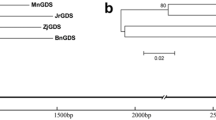Abstract
Plant hormone jasmonates play an important role in the response of plants to environmental stress. Jasmonate ZIM-do-main (JAZ) family proteins are key elements in the jasmonate signaling pathway. In Arabidopsis thaliana (Arabidopsis), the JAZ2 (At1g74950) gene expresses at a low level in the entire plant, but the response can be strongly and quickly induced by MeJA. The promoter sequence (1389 bp) of JAZ2 from Arabi-dopsis genome was cloned and linked to a GFP reporter gene, and we then investigated the transient expression of GFP in Populus trichocarpa protoplasts. After treating the transformed protoplasts with MeJA, we observed the GFP fluorescence and quantified its mRNA transcription level. The results showed that the Arabidopsis JAZ2 promoter was able to drive GFP expression, and also responded to MeJA in Populus trichocarpa mesophyll protoplasts. The analysis of promoter sequences of JAZ gene family members showed that there were several conserved motifs, which were related to jas-monate signaling, such as G-box (CACGTG), CGTCA-motif (CGTCA) and TGACG-box (TGACG), and also some known cis-acting regulatory elements involved in other aspects, however the function of these motifs still needs further study.
Similar content being viewed by others
References
Boter M, Ruiz-Rivero O, Abdeen A & Prat S, 2004. Conserved MYC transcription factors play a key role in jasmonate signaling both in tomato and Arabidopsis. Genes Dev 18, 1577–1591.
Brown RL, Kazan K, McGrath KC, Maclean DJ & Manners JM, 2003. A role for the GCC-box in jasmonate-mediated activation of the PDF1. 2 gene of Arabidopsis. Plant Physiol 132, 1020–1032.
Chini A, Fonseca S, Fernandez G, Adie B, Chico JM, Lorenzo O, Garcia-Casado G, Lopez-Vidriero I, Lozano FM, Ponce MR, Micol JL & Solano R, 2007. The JAZ family of repressors is the missing link in jasmonate signalling. Nature 448, 666–671.
Chung HS, Koo AJK, Gao X, Jayanty S, Thines B, Jones AD & Howe GA, 2008. Regulation and function of Arabidopsis JASMONATE ZIM-domain genes in response to wounding and herbivory. Plant Physiol 146, 952–964.
Creelman RA & Mullet JE, 1997. Biosynthesis and action of jasmonates in plants. Annu Rev Plant Physiol Plant Mol Biol 48, 355–381.
Farmer EE, Almeras E & Krishnamurthym V, 2003. Jasmonates and related oxylipins in plant responses to pathogenesis and herbivory. Curr Opin Plant Biol 6, 372–378.
Finnegan J & McElroy D, 1994. Transgene inactivation: plants fight back! Biotechnol 12, 883–888.
Kang H, Kang SG, Bae H, Park KS & Hall RB, 1997. Transient expression of beta-glucuronidase (GUS) gene in immature ovules and calli derived from cottonwood species (Populus deltoides) by microprojectile bombardment. J Kor Forest Soc 86, 261–269.
Leron K, Hoo SC, Abraham J & Gregg AH, 2008. Jasmonate signaling: a conserved mechanism of hormone sensing. Curr Opin Plant Biol 11, 428–435.
Li A, Chen L, Ren H, Wang X, Zhang H & Huang RF, 2008. Analysis of the essential DNA region for OsEBP-89 promoter in response to methyl jasmonic acid. Sci China C Life Sci 51, 280–285.
Major IT & Constabel CP, 2006. Molecular analysis of poplar defense against herbivory: comparison of wound- and insect elicitor-induced gene expressionression data generated by quantitative realtime RT-PCR. Biotechniques 32, 1372–1379.
Nowak K, Luniak N, Meyer S, Schulze J, Mendel RR & Hänsch R, 2004. Fluorescent proteins in poplar: A useful tool to study promoter function and protein location. Plant Biol 6, 65–73.
Obayashi T, Kinoshita K, Nakai K, Shibaoka M, Hayashi S, Saeki M, Shibata D, Saito K & Ohta H, 2007. ATTED-II: a database of co-expressed genes and cis elements for identifying co-regulated gene groups in Arabidopsis. Nucleic Acids Res 35, 863–869.
Sa Q, Wang Y, Li W, Zhang L & Sun Y, 2003. The promoter of an antifungal protein gene from Gastrodia elata confers tissue-specific and fungus-inducible expression patterns and responds to both salicylic acid and jasmonic acid. Plant Cell Rep 22, 79–84.
Sheard LB, Tan X, Mao H, Withers J, Ben-Nissan G, Hinds TR, Kobayashi Y, Hsu FF, Sharon M, Browse J, He SY, Rizo J, Howe GA & Zheng N, 2010. Jasmonate perception by ino-sitol-phosphate-potentiated COI1-JAZ co-receptor. Nature 468, 400–405.
Thines B, Katsir L, Melotto M, Niu Y, Mandaokar A, Liu G, Nomura K, He SY, Howe GA & Browse J, 2007. JAZ repressor proteins are targets of the SCF (COI1) complex during jasmonate signalling. Nature 448, 661–665.
Xu M, Zhang B, Su X, Zhang S & Huang M, 2011. Reference gene selection for quantitative real-time polymerase chain reaction in Populus. Anal Biochem 408, 337–339.
Yan J, Zhang C, Gu M, Bai Z, Zhang W, Qi T, Cheng Z, Peng W, Luo H, Nan F, Wang Z & Xie D, 2009. The Arabidopsis CORONATINE INSENSITIVE1 protein is a jasmonate receptor. Plant Cell 21, 2220–36.
Author information
Authors and Affiliations
Corresponding author
Rights and permissions
About this article
Cite this article
Wang, Y., Liu, GJ., Yan, XF. et al. MeJA-inducible expression of the heterologous JAZ2 promoter from Arabidopsis in Populus trichocarpa protoplasts. J Plant Dis Prot 118, 69–74 (2011). https://doi.org/10.1007/BF03356384
Received:
Accepted:
Published:
Issue Date:
DOI: https://doi.org/10.1007/BF03356384




